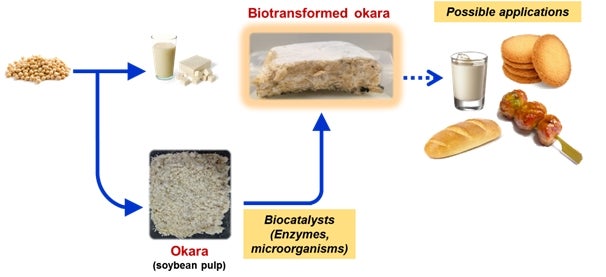Okara: Biotransformed and back in action
October 26, 201726 Oct 2017. NUS food scientists have given okara, a soybean byproduct, a nutritional and flavour makeover using various enzymes and beneficial microbes.
One way to avoid food wastage is to finish all the food served, but how about food that does not make it to the dining table?
An example of this is okara, the soybean residue that remains after the production of soymilk and tofu. About 10,000 tonnes of okara are produced annually in Singapore as a byproduct. Okara spoils easily, has an unpleasant smell and is not palatable, so most soy food producers usually dispose it. This creates food waste.
With the aim of reducing food wastage, Prof LIU Shao Quan and his research team from the Food Science and Technology Programme at the Department of Chemistry, NUS have developed a biotransformation process for okara using a combination of natural microorganisms and enzymes to convert it into a high-value food ingredient with better nutritional value and enhanced flavour. After this transformation, the okara contains more soluble fibre, which helps to maintain gut health. It also acquires a meaty taste and becomes easier to digest as the insoluble fibres are broken down. This makes it suitable for a variety of food products, such as baked goods and meat substitutes.
Prof Liu said, “The biotransformation process requires adding a microbial starter to (steamed and cooled) okara, and allowing it to ferment in a clean, enclosed space for about one to two days. Okara is essentially free (or very cheap), and the starters are very affordable. The main cost involved will be in transporting the okara, steaming it and having the space for biotransformation to take place.”
Ms VONG Weng Chan, a Ph.D. student on the research team, said, “The okara can be fermented directly after it is produced, without the need for intermediate processing. Also, the high moisture content in okara promotes microbial growth, enhancing the fermentation process.”
“This process is straightforward, natural and does not produce waste streams. The biotransformed okara is nutritious, plant-based and has the potential to be used in a variety of food products,” added Prof Liu.

Flowchart illustrates the process flow from soybean to biotransformed okara, with potential applications in food products. [Image credit: Vong Weng Chan]
Reference:
Vong WC; Lim XY; Liu SQ*, “Biotransformation with cellulase, hemicellulase and Yarrowia lipolytica boosts health benefits of okara” APPLIED MICROBIOLOGY AND BIOTECHNOLOGY. Volume: 101 Issue: 19 Pages: 1-12 DOI: 10.1007/s00253-017-8431-1 Published: 2017.


